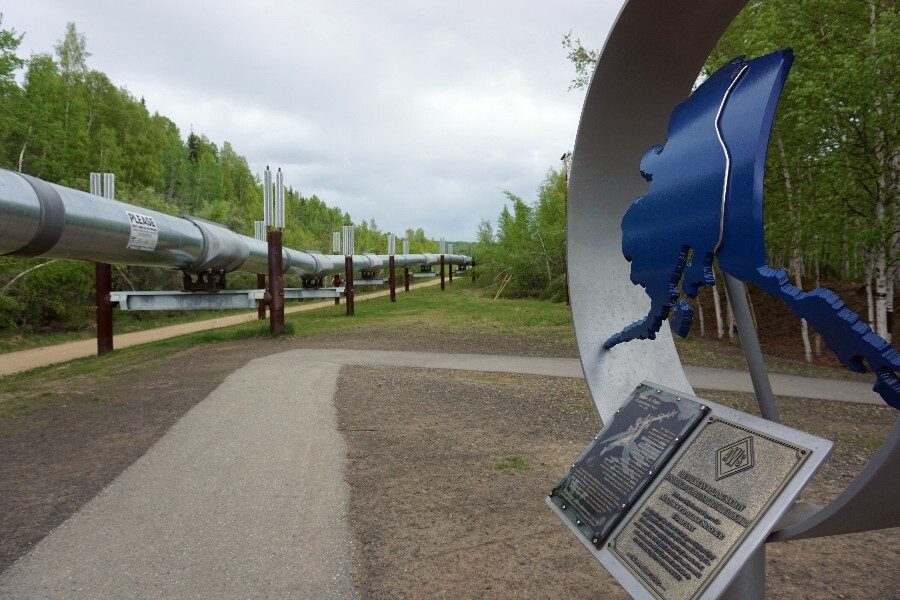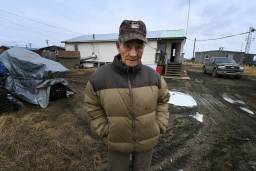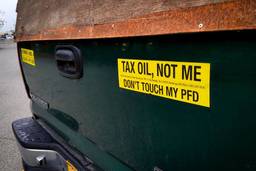
Siqiniq Maupin, a young Inupiat mother and activist trying to help steer Alaska away from its fossil-fuel dependency, is convinced that the coronavirus pandemic will be a turning point. Oil prices have cratered, the industry has shed hundreds of jobs and the usual flow of oil money has dried up, signaling the urgent need for a “Plan B,” she said.
“Personally, I think this is absolutely the end of the oil era, and I think this is going to be an abrupt wake-up call for people,” she said in a phone interview from her Fairbanks home.
Though a harsh critic of oil development, Maupin acknowledges that oil money brought important improvements to rural Alaskans’ lives, like running water and flush toilets. “It’s nice to have the necessities,” she said.
But oil money came with costs. For her family members and others living on the North Slope, the coronavirus pandemic has put those costs into stark relief, she said.
For years, she explained, Inupiat-owned corporations made money from oil development, enabling them to distribute hefty shareholder dividends that blunted the sticker shock for people buying high-priced food in village stores. Indigenous people of the North Slope could afford to drop some of their reliance on traditional wild foods like caribou meat and fish.
Now that the money has gotten scarce, many people have begun to return to more traditional diets ― and been forced to confront the habitat damage wrought by decades of oil development, Maupin said.
In the North Slope village of Nuiqsut, where some of Maupin’s family members live, oil development has edged up almost to Nuiqsut’s doorstep, bringing dust, hazy pollution, industrial noise and bright lights to the village. “You can’t really escape it,” she said. Gathering traditional food is now more difficult and time-consuming, she said; caribou that used to roam in easy reach nearby, for example, have now fled to distant areas. And the in-your-face presence of industry is stressful, she said: “It takes away that medicine that we’re looking for when we go out on the land to hunt.”
In many ways, the dilemma facing Maupin’s relatives and friends symbolizes the challenge facing Alaska as a whole.
For decades, oil money carried Alaska. That was by design. The state constitution, drafted in the 1950s territorial era, and the subsequent federal law that granted statehood, structured a system of common public ownership of all natural resources, including oil. Almost every barrel of oil ever produced in the state has come from state lands and state-owned mineral rights. In Alaska, there is no private individual ownership of mineral rights; there are no Texas-style oil barons. Some historians insist that the presence of oil in the far north convinced Congress that Alaska had the wherewithal to support itself as the 49th state.
For a long time, the system worked more or less as many envisioned. Oil royalties, taxes and fees flowed into the state treasury and paid for nearly all government operations, including mass-scale modernizations and services new to Alaska but taken for granted in the Lower 48. Oil development spurred the 1971 Alaska Native Claims Settlement Act, creating money-making corporations that lifted many Alaska Natives out of poverty. Oil employment, though always far less important than state oil revenues, was a significant part of the private-sector economy. In many ways, oil money built modern Alaska.
But the all-eggs-in-one-basket approach carried risks, experts have long warned.
Among the prescient observers was Inupiat leader Eben Hopson, the first mayor of the North Slope Borough, the regional government created in 1972. Even before construction started on the Trans Alaska Pipeline, he warned of the downsides of oil money – skewed values and an unhealthy dependence, including among Alaska’s indigenous peoples. “The politics of the Arctic are no longer the politics of the people, but they are the politics of oil,” Hopson said in a 1970 speech to a Canadian commission considering Arctic offshore drilling. “Oil boom politics are addictive.”
Others, also warning about the transitory nature of oil fields and oil money, pushed for the state to save some of its newfound bounty. Just before the first barrel was sent down the Trans Alaska Pipeline in 1977, the state created the Alaska Permanent Fund to sequester a quarter of royalties and lease payments for use in a distant post-oil-money future.
That future may have arrived. Alaska, once the top oil-producing U.S. state, had slipped out of the top five by 2018. The Alaska Permanent Fund, famous for its annual dividends paid out to all Alaskans, is now the major money source bankrolling most of state government operations. Oil’s contribution to total state revenues, which sat at 90 percent just a few years ago, has plunged as production declined and North Slope crude prices bottomed out below $10 a barrel in late April.
“It’s gone down to 20 percent, and if we’re at $10-a-barrel (oil) now, it’s way less than 20 percent,” said Pat Pitney, a legislative budget analyst who served as budget director for former Gov. Bill Walker.
The shift from reliance on oil revenues to reliance on investment earnings actually began a few years ago. Alaska oil production was on a decades-long decline, the inevitable reality for oil fields as they age. But the coronavirus pandemic, which depressed oil prices and created other operational problems for remote work sites like the North Slope oil fields, pushed that long-term decline into a steep plunge. As a Hemingway character put it in response to the question of how he went bankrupt, “two ways: gradually, then suddenly.”
Companies operating on the North Slope have slashed operations to maintenance levels, mothballed drill rigs, halted exploration and development programs and issued layoff notices to several hundred workers. ConocoPhillips, the state’s top producer, announced plans to cut summer production by 100,000 barrels a day. Alaska oil production peaked in 1988 at 2 million barrels per day but has dropped to around 400,000 barrels per day.
The current oil-field shock has created an immediate fiscal emergency for the state: a $1 billion hole in the state’s $5 billion budget, Pitney said. “How do you make up a billion dollars?” she asked. A state income tax would have been a partial answer, but Alaska in the heady oil-money days of 1980 abolished its income tax.
Are Alaska’s days as a petrostate over? Pitney believes that Alaska will produce oil for years to come, generating some state revenue and employment, but the scope will be nothing like it was in the past. “Oil’s never going to be the savior that it was for the last 35 years,” she said.
Industry representatives who testified at a May 8 teleconference legislative hearing echoed predictions of a permanently shrunken Alaska oil sector. They asked for state government help, possibly in the form of tax policy or regulatory relief, to survive a post-pandemic future that they said might be dominated by cheaper energy sources.
“We know that this demand situation and hopefully the price situation will not last forever,” said Kara Moriarty, executive director of the Alaska Oil and Gas Association, told lawmakers. “As we come out of this, a more competitive landscape than ever before is expected to emerge.” In short: Alaska oil will have a harder time getting investment or space in the market unless there is some help from the state government.
Due to its high costs and remote Arctic setting, Alaska was losing out to competitors even before the pandemic, said Damian Bilbao, a vice president for BP Alaska, the company that operates the supergiant Prudhoe Bay field. “The decline in Alaska production during the early 2000s seems to have led several West Coast refineries to invest in preparation for other sources of oil,” Bilbao told lawmakers.
BP itself is heading for the exit. After 60 years in Alaska, the oil giant is selling its assets here to the much smaller, privately held Hilcorp Energy Company. If the deal goes through as planned, Hilcorp will run a dramatically streamlined Alaska operation, with hundreds fewer employees and other changes. The tall BP office building, a landmark looming over midtown Anchorage, could stand largely empty after the sale goes through. Hilcorp, the company’s top Alaska executive told lawmakers in February, has no plans to move into it.







